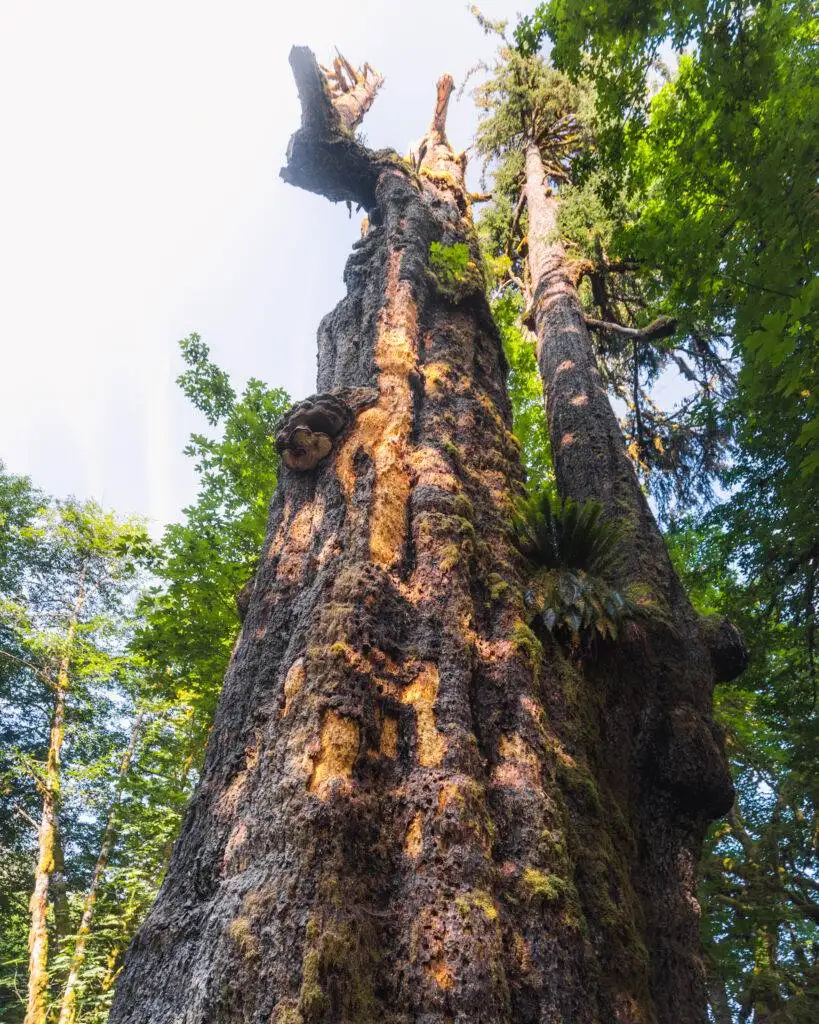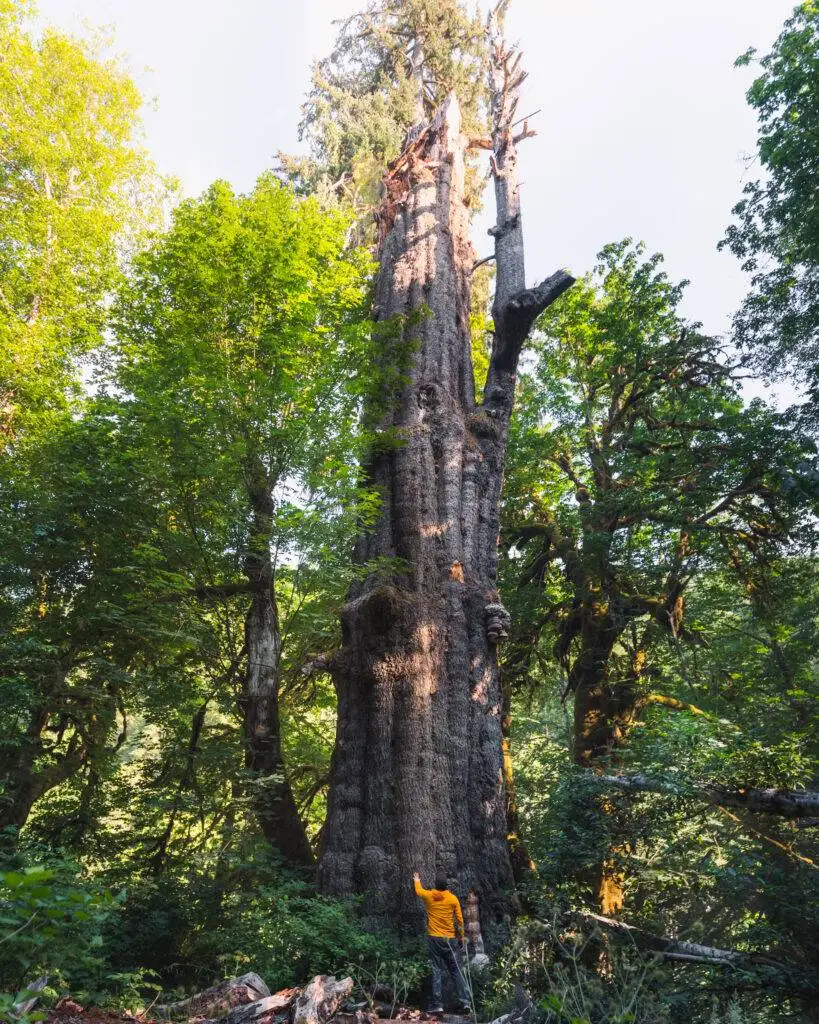Visitors to Vancouver Island in search of Canada’s largest Sitka Spruce tree will be sorry to learn that the famous San Juan Spruce near Port Renfrew no longer holds the title. This once-record holding tree was measured at a lofty 62.5 meters of height and 11.6 meter circumference at the base, making it not only the largest in Canada, but second-largest in the world. Sadly a lightning strike badly damaged the tree sometime in 2016 and further damage from wind has caused most of the tree to collapse on itself. Presumably as a result of the San Juan Spruce no longer being quite so record-breaking, as well as safety concerns of further branches falling, the recreation site at the base of the tree has been permanently closed and left to be overtaken by the forest.
That said, it’s still very possible to visit what remains of this impressive tree – and to be clear – the San Juan Spruce is still very impressive – with or without its top. Even in a region with plenty of big old-growth trees to visit, the massive bulk of the trunk of the San Juan Spruce stands out. Despite the damage, I still consider a visit to the San Juan Spruce a great thing to do near Port Renfrew – with one major caveat. There are a number of broken branches that have crashed down beneath the tree, and I would think very carefully about standing around the base of the San Juan Spruce on a windy day due to very real safety concerns.
Continue reading this blog post for everything you need to know to experience the San Juan Spruce near Port Renfrew for yourself.

When hiking it’s important to avoid harmful practices such as disturbing plants or rock-stacking, or removing any natural object from flowers to rocks, as it’s important to leave the environment as natural as possible for the animals and for fellow hikers to enjoy in perpetuity. As many flowers as there are, there are few enough that if we all took one, then there wouldn’t be any left. Take only photos, leave only footprints.
If you haven’t heard of Leave No Trace principles, they’re also really essential to read up on before heading anywhere into the outdoors in general. Following these important principles basically means doing your best to leave beautiful places like the San Juan Spruce as good (if not better) than you found them, both for their preservation and for the enjoyment of other visitors.

How to Get to the San Juan Spruce
The San Juan Spruce is located close to Port Renfrew, only about a half hour drive away. Most of the drive is along the Pacific Marine Road north towards Cowichan Lake, but after turning off just before Lizard Lake the last 5 kms of the ride are along active logging road. From the first main intersection at the start of town in Port Renfrew, turn north onto Deering Road, following signs for Lake Cowichan. Follow Deering Road for 3 km as it crosses a couple of bridges before turning right at a T intersection onto Pacific Marine Road, continuing to follow signs for Lake Cowichan. After just under 13 km of driving the road will split into the asphalt road on the left with a gravel logging road on the right. Straight ahead in the middle of the V is a large yellow caution sign. Turn right here onto Lens Main and follow the logging road for 5 kms. Just after a bridge over the San Juan River you’ll see a turnoff to the left that has been deactivated and dirt piled up on the road. It’s no longer possible to drive into the San Juan Spruce Recreation Site but if you park here on the start of the deactivated entrance road it’s a short walk in.
Click here to open the exact trailhead location in Google Maps.
Recommended Hiking Gear



Water is a must whenever I’m hiking, especially if the sun is going to be out. My favourite water filter I’ve used is the Katadyn BeFree 0.6L, which unlike other water filters I’ve used packs up really small and lightweight. For hikes where I know there won’t be any readily available water sources along the way, I make sure to bring my own. The Hydrapak Stow 1L bottle is my go-to, for the same reason that it’s made of a soft plastic that folds up and doesn’t take up any more extra space than necessary in my pack. Finally, Aquatabs are another great option for purifying water, with one tablet being suitable for one litre of water. I previously used the Grayl water filter while travelling internationally, and though I found its hard body more convenient for day to day use and easier to drink from, it has a little too much bulk for my fast-and-light style of hiking.



The secret to all my photos of gorgeous sunset and sunrise mountaintop views? A lot of hiking in the dark. And let me speak from personal experience when I say that the last thing that you want to happen when hiking is to be caught in the dark without a headlamp. I used the Black Diamond Spot 400 for years and it worked great – until I lost it on top of a mountain somewhere. The only downside to it was having to worry about the batteries dying, though there’s also a slightly more expensive version that has a rechargeable battery. Nowadays I’m using the Petzl Actik Core, which is a bit pricier than the more budget-friendly Black Diamond, but is also brighter, more comfortable (in my opinion), and has a hybrid power system that is rechargeable but can also take AAA batteries if needed.
You won’t see me using trekking poles on shorter hikes often – but on long hikes and backpacking trips, as well as certain scrambles, they are an absolute lifesaver. I’ve invested in a high quality ultra-lightweight pair of MSR DynaLock Ascent carbon poles which, while pricey, I don’t regret one bit. If you’re not entirely sure how much use you’re going to get out of a pair of trekking poles, the best budget-friendly option would be the Trekology Trek Z 2.0. Amazon does sell a lot of cheaper Made in China-style trekking poles for cheaper, but these usually are much much heavier and not worth buying.
All the best and most long-lasting cables and power banks I’ve ever owned have been Anker. I once had a phone cable from them that lasted me over three years of daily use! That’s why I keep an Anker PowerCore Essential 20K power bank on me. Like many people I use my phone for a lot of stuff when hiking (checking in with family, using online maps, taking photos, flying my drone) so I like to be prepared for that low battery warning by having a backup power source on me just in case.



The only socks I ever buy for myself are from Darn Tough, and I almost always make sure to wear them when hiking. After years of having no problems only wearing these comfortable and rugged socks for hikes, I accidentally wore a pair of no-name socks on a hike last year and ended up with blisters on both feet. Safe to say I’m back to sticking with the Darn Tough. And the best part? They have a lifetime guarantee, meaning that if they ever wear out you can send them back for a brand new pair. For hiking footwear I go between a pair of lightweight approach shoes for quick and dirty mountain ascents or anything involving scrambling and more heavy-duty boots for longer treks. I’ve worn a couple different versions of the lightweight but super durable Arc’teryx Konseal FL 2 approach shoes for a few years now and am very impressed with the durability. I also really like the thick toecap that keeps me protected every time I stumble into a root or large rock. For longer, tougher, or muddier treks I rely on my LOWA Camino EVO GTX, which I find insanely comfortable and made of very high quality.



I wear my Ar’teryx Gamma Lightweight Pants on every single hike I go on, and on many days when I’m not hiking. After several years of abuse they are still holding together extraordinarily well, with only a few small holes from where I’ve fallen down and some slight stains from being repeatedly coated with mud. They’re lightweight, breathable, and super comfortable. For lightweight and breathable hiking tops I’m a big fan of both the Patagonia Capilene Shirt and the MEC Core Shirt. My Arc’teryx Squamish Hoody shows up in a lot of my photos. It’s super lightweight and packable, and does a great job of cutting the wind while also being pretty breathable. I also have an Arc’teryx Atom Hoody and Arc’teryx Beta LT that I pull out for cooler or wetter conditions.
I hope you enjoyed this guide to the San Juan Spruce near Port Renfrew on Vancouver Island! Feel free to leave any questions in the comment section below or to contact me directly via social media.
